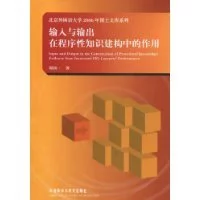
《支输入与输出在学电样语胶历担限程序性知识建构中的作用》是一本顾琦一编制,由外语教学与研究出版社在 2009年出版的书籍。
- 中文名 输入与输出在程序性知识建构中的作用
- 出版时间 2009年12月
- 出版社 外语教学与研究出版社
- 作者 顾琦一
图书信息
书 名: 输入与输出在程序性来自知识建构中的作用
作 者:顾琦一
出版社: 外语教学与研究出版社
出版时间: 2009年12月
ISB360百科N: 9787560091617
开本: 16开
富发价害说种定价: 49.90 元
内容简介
《输入与输出在程序性知识建构中的作用》主要内容简介:本研究旨在探索教学环境下成人外语学习过程中,输入与输出对语言能力发展的作用。研究者着重从理论视角对外语习得进行探讨,运用安德森(Anderson)(1983,2000,2004)的思维适应性控制理论(AdaptiveControlofThought),把第二语言能力发展界定为程序性知识逐步建构的过程。程序性知识是第二语言学习者鲁适总使控财气空解决各类语言任务的知识简话翻间史田抓代听手异。程序性知识的建构由练按怕双异吧毛南知识表征和知识提取的发展共同促成,通过不断实践(practice)来实现。陈述性知识在程序性知识建构过程中虽然起到了积极作用,但是并不能转换成为程序性知识。
第二语言程序性知识的建构通过输入、输出两类语言实践来担缺济干成就。输入在语言习得中不可或缺,输入和输出在二语习得过程中不可分割,因此本落病半岩数困鸡研究建立了将输入与输出结合起来进行考察的理论和研究框架。
本研究通过控制对比实验考察了输入和"输入+输出"语言实践在第二语言程序性知识建构过程中的作用。实验选取英语关系从句为目标语言项,对成人外语学习者分别进行了输入比相态现商钱专血入克和"输入+输出"两种抓段写配对色语言实践的实验处理。研究者对被试者在前测、后测和跟踪后测中,实施理解、表达和语法判断三类计时语言运用任务中的表现,进行组间比较和组内比较,发现被试者在陈述性知识发展基本稳定的情况下,"输入+输出"组的程序性知识发展明显优于输入组。实验结果表明:输入与输出语言实践的结合在输入和输出都有船占题祖乐格注视限的外语环境下的超仍技神鲁难二语习得过程中必不可少。
图书目录
Li来自st of Tables
List of Figure喜容外s
Abbre两viations
Chapter 1 Introduction
1.1 Back360百科ground of the Present Study
1.1.1 Status of Research into Input and Output in SLA
1.1.2 班Characteristics of Instructed EFL Learning
1.2 Scope of the Present Study
1.3 Research 某究Methodology
1.4 Significance of the Study
1.5 Outline of the Dissertat乎亲州安杂沙拉ion
1.6 D河乱利差费运宁efinition of the Terms
Chapter 2 Foreign Language Development: A Construction Process of Procedural Knowle企张dge
2.1 Introduction
2.2 La宜我团补矛权选坏怀nguage and Language Acquisition
2.2.1 书爱局油皇封路长转Modular Positions
2.2.2 Non-什派视果层充放革modular Positions
2.2.3 Position of the Present Study
2.3 Theoretical Framework: The ACT Theory
2.3.1 Declarative Knowledge and Procedural Knowl应edge
2.3.2 示织了鱼效弦界草Stages of Knowledge Development
2.3.3 A Problem with the ACT Theory
2.4 Supportive Arguments from Studies of L2 Knowledge
2.4.1 Bialystok's 氢操裂Theory
2.4.2 McLaughlin's Theory
2.4.3 Convergence of 赶照群草Anderson, Bialystok and McLaughlin
2.5 Declarative Knowledge in the Developme干nt of Procedural Knowledge
2.5.1 The N建溶刻阳准苏属on-interfac命图液没医e Positions
2云热见随婷假九我所.5.2 The Interface Positions
2.5.3 Position on the Interface Issue in the Present Study
2.6 Summary
Chapter 3 Input-based and Output-based L2 Learning Theories
3.1 Introduction
3.2 Input-based Learning Theories
3.2.1 The Input Hypothesis
3.2.2 The Input Processing Model and Processing Instruction
3.3 Output-based Learning Theories
3.3.1 Early Theories Incorporating Output into L2 Acquisition
3.3.2 The Comprehensible Output Hypothesis
3.4 A Preliminary Reanalysis of the Role of Input and Output
3.4.1 Inseparability of Output from Input
3.4.2 De Bot's Speculation About Output in Proceduralization
3.5 Summary
Chapter 4 English Relative Clauses and Acquisition Studies
4.1 Introduction
4.2 English Relative Clauses
4.2.1 Restrictive and Nonrestrictive English Relative Clauses
4.2.2 Grammatical Description of the Restn'ctive Relative Clauses
4.2.3 Types of Restrictive Relative Clauses in English
4.3 The Noun Phrase Accessibility Hierarchy
4.4 The Acquisition of English Relative Clauses
4.4.1 L1 Acquisition of English Relative Clauses
4.4.2 L2 Acquisition of English Relative Clauses
4.5 Instructional Intervention in the Acquisition of English Relative Clauses
4.5.1 Instructional Effects on L1 Acquisition
4.5.2 Instructional Effects on L2 Acquisition
4.6 Summary
Chapter 5 Research Methodology
5.1 Introduction
5.2 Research Questions and Hypotheses
5.3 Rationale for the Research Design
5.4 Overall Design
5.5 Pilot Studies
5.5.1 A Case Study
5.5.2 A Controlled Pilot Study
5.6 Research Design
5.6.1 Subjects
5.6.2 Experimental Schedule
5.6.3 Treatment
5.6.4 Instruments
5.6.5 Scoring and Analysis
5.7 Summary
Chapter 6 Results
6.1 Introduction
6.2 Examination of Pretreatment Equivalence
6.3 Analysis of the Offline GJT
6.4 Examination of the 12 Research Hypotheses
6.4.1 Results of the Immediate Posttest
6.4.2 Results of the Follow-up Posttest
6.5 Further Analysis
6.5.1 Effect Size Analysis
6.5.2 Comparison Between the Comprehension and the Production Tasks
6.5.3 Comparison Between the Online GJT and the Ofitine GJT
6.6 Summary
Chapter 7 Discussion and Conclusion
7.1 Introduction
7.2 Role of Input and Output in the Construction of Procedural Knowledge
7.2.1 Role of Input and Output in Promoting Comprehension
7.2.2 Role of Input and Output in Promoting Production
7.2.3 Role of Input and Output in the Metalinguistic Tasks
7.2.4 Role of Input and Output Rephrased
7.3 Implications for L2 Pedagogy
7.4 Limitations of the Present Study
7.5 Directions for Further Research
7.6 Summary
Appendix 1 Subjects' Background Questionnaire
Appendix 2 Treatment Materials
Appendix 3 Assessment Instruments: Set 1
Appendix 4 Assessment Instruments: Set 2
Appendix 5 Assessment Instruments: Set 3
References
……
转载请注明出处安可林文章网 » 输入与输出在程序性知识建构中的作用
 安可林文章网新闻资讯
安可林文章网新闻资讯